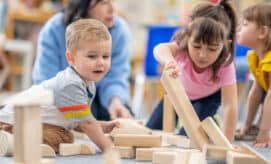As early learning professionals, we know that our play and learning spaces influence the way the children in our care feel, act, and learn. Because young children learn through play, ECE environments that have been designed to invite play and playful exploration have a positive impact on early learning and development.
Below is a list of simple tips and ideas to keep in mind as you consider options for setting up or refreshing your early learning space. Whether you are in a center-based program, or running a home-based learning center, you can create an early learning environment that is both inviting and interesting for the little ones in your care!
Consider the Child’s Level
When you look around your room, notice which items are displayed at the children’s level. Are there baskets of play and learning items kept at children’s eye level and within reach? Is the children’s art displayed at a height where they can see it? Children are more likely to explore when materials are placed near play centers and at eye level, so they can access them easily on their own.
Offer a Variety of Materials
Fill baskets with items that inspire different ways of playing and learning. You might, for example, have baskets containing building materials, such as blocks and Magna-Tiles; baskets with items that inspire pretend play, like dress-up clothes or baby dolls; and baskets filled with colorful picture books. You can make the baskets especially inviting by filling them with items that feature a variety of textures and colors.
Maintain Indoor Open Spaces
Although we want to offer children a variety of engaging materials, we also want to make sure that these materials are arranged in a way that leaves plenty of open space in the classroom. The open space should be large enough for multiple children to sit at one time, so children can choose to play with or alongside one another. Room to be together gives little ones the opportunity to communicate, collaborate, and work with their peers. Open spaces also enable children to move freely throughout the room, which encourages them to explore and engage with all that the space has to offer.
Include the Families
When children feel safe, cared for, and welcomed, they are more likely to play and explore freely. Incorporating photos of the children’s families into your classroom can help bridge the connection between life at home and school, reinforcing each child’s sense of safety and belonging. You might hang photos on the walls or make photo albums that children can flip through. Photos can be especially comforting to young children who are missing their families or experiencing separation anxiety while at school.
Bring Nature Indoors
Incorporating natural elements into your classroom design has a number of benefits. Nature helps create a calming environment for little ones, while sparking children’s sense of wonder about the world around them, encouraging them to ask questions, investigate, and explore. You can bring nature indoors by placing plants around the room for children to observe and help care for, incorporating flowers or leaves into art projects, or simply opening the blinds to let in the natural sunlight.





